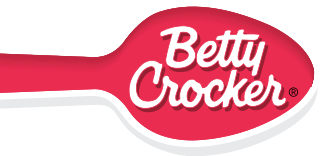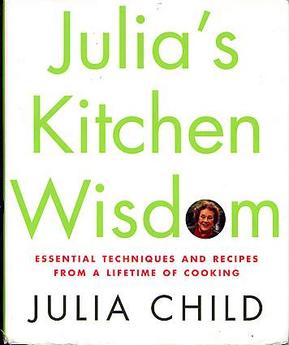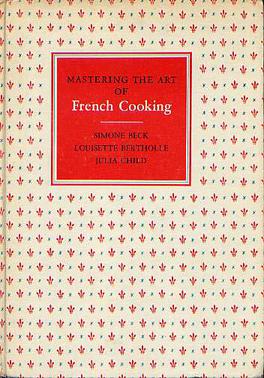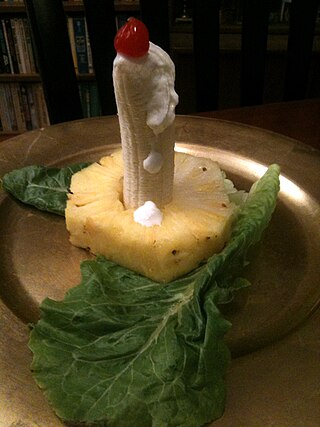
A cookbook or cookery book is a kitchen reference containing recipes.

Betty Crocker is a brand and fictional character used in advertising campaigns for food and recipes. The character was originally created by the Washburn-Crosby Company in 1921 following a contest in the Saturday Evening Post. In 1954, General Mills introduced the red spoon logo with her signature, placing it on Gold Medal flour, Bisquick, and cake-mix packages. A portrait of Betty Crocker, first commissioned in 1936 and revised several times since, appears on printed advertisements and product packaging.

Julia's Kitchen Wisdom is the final cookbook authored by chef and television personality Julia Child. Co-authored by David Nussbaum and edited by Judith Jones, the book covers basic cooking principles and techniques and was designed to serve as a reference point for amateur cooks. Julia's Kitchen Wisdom was the 17th book written by Child and gained widespread popularity following the release of the 2009 film, 'Julie and Julia'.

Red velvet cake is traditionally a red, crimson, or scarlet-colored layer cake, layered with ermine icing. Traditional recipes do not use food coloring, with the red color due to non-Dutched, anthocyanin-rich cocoa.

Depression cake is a type of cake that was commonly made during the Great Depression. The ingredients include little or no milk, sugar, butter, or eggs, because the ingredients were then either expensive or hard to obtain. Similar cakes are known as "War Cake", as they avoided ingredients that were scarce or were being conserved for the use of soldiers. A common depression cake is also known as "Boiled Raisin Cake", "Milkless, Eggless, Butterless Cake", or "Poor Man's Cake". "Boiled" refers to the boiling of raisins with the sugar and spices to make a syrup base early in the recipe. However, some bakers do include butter. Boiled raisin-type cakes date back at least to the American Civil War.

Mastering the Art of French Cooking is a two-volume French cookbook written by Simone Beck and Louisette Bertholle, both from France, and Julia Child, who was from the United States. The book was written for the American market and published by Knopf in 1961 and 1970.

Marjorie Husted was an American home economist and businesswoman who worked for General Mills and was responsible for the success and fame of the brand character Betty Crocker. Husted wrote Betty Crocker's radio scripts and was her radio voice for a time.

A sandwich loaf is a stacked savory party entrée made from a loaf of horizontally sliced bread. Typical fillings include egg salad, chicken salad, ham salad, tuna salad, and Cheez Whiz. While rare today, the food was quite popular during the mid 20th century in the United States.

Onion cake is a savory or sweet cake prepared using onion as a primary ingredient. Various onion cakes are consumed in Canada, China, Germany, Korea, Switzerland, Wales and other countries. Several types and varieties of onion cakes exist, including laobing, pajeon, the scallion pancake, Edmonton-style green onion cake, teisen nionod and zwiebelkuchen.

Ambrose Heath was an English journalist and food writer. He authored many cookbooks.
Margo Oliver was a Canadian cookery expert. She was the food editor of Weekend Magazine and wrote a number of cookbooks as well as articles on the subject of cooking.

Candle salad is a vintage fruit salad that was popular in America from the 1920s through to the 1960s. The salad is typically composed of lettuce, pineapple, banana, cherry, and either mayonnaise or, according to some recipes, cottage cheese. Whipped cream may also be used. The ingredients are assembled to resemble a lit candle.
The Betty Crocker Kitchens is a division and part of the test kitchens at the world headquarters of General Mills in Golden Valley, Minnesota, operator of the Betty Crocker brand. They are modeled after and equipped like a kitchen that would be found in an American home, since the company's products and recipes tested are intended for home use. Marjorie Husted, an economist hired by the Washburn-Crosby company, was not only a key player in developing the persona of Betty Crocker but also recognized the subtle difference in how home cooks measured and approached recipes compared to how these recipes were made in the test kitchens. Based on her cooking instruction experience, Hustad felt that Betty Crocker's recipes need to be reliable and fool-proof for the home cook. She passed her observations on to the company's research department.

Pamela Clark is an Australian chef, cookbook author and food presenter, and has been associated with The Australian Women's Weekly for 50 years.
In the 1950s, commercial cookbooks gained popularity in the United States. These cookbooks frequently suggested the use of packaged food and electric appliances, which had become more available due to the post-war economic boom. Cookbooks reflected these changes. Betty Crocker and Julia Child became popular icons in American culture through their cookbooks and the media during this era. Cookbooks also reflected many cultural trends of the 1950s, especially typical gender roles and racial identities. Many cookbooks were addressed to the white, middle-class housewife who cooked for her family in their suburban home. These cookbooks often excluded African-American, immigrant, and rural women. For them, handwritten cookbooks served as both personal histories and a means to express their views on politics and society. Meanwhile, advertisements promoted the racial stereotype of the “black mammy” that de-feminized African-American cooks in white households. Ethnic immigrants were also debased as European Americans baked their distinct cuisines into generic casseroles.
Maria Guarnaschelli was an American cookbook editor and publisher. In a career spanning five decades she worked with and groomed popular food authors including Rose Levy Beranbaum, Rick Bayless, Julie Sahni, Fuchsia Dunlop, J. Kenji López-Alt, and Judy Rodgers. Some of the notable cookbooks published by her included Classical Indian Cooking,All New All Purpose Joy of Cooking, The Food Lab, The Zuni Cafe Cookbook, and The Cake Bible. Her works were noted to have contributed to a change in how cookbooks were produced, and also credited with introducing American households and chefs to international cuisines beyond just European cuisines.
The Essential New York Times Cookbook is a cookbook published by W. W. Norton & Company and authored by former The New York Times food editor Amanda Hesser. The book was originally published in October 2010 and contains over 1,400 recipes from the past 150 years in The New York Times, all of which were tested by Hesser and her assistant, Merrill Stubbs, prior to the book's publication. The book has recipes dating from the mid 1850s, when The New York Times first began publishing topics about food and recipes.
Agnes White Tizard was an American home economist and nutrition consultant who worked for General Mills and was associated with the brand character Betty Crocker. Tizard was the voice of Crocker on the radio for 20 years, and wrote the original Betty Crocker Cookbook in 1950. Tizard was the first host of a radio cooking program in the United States.












